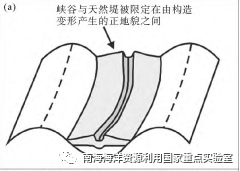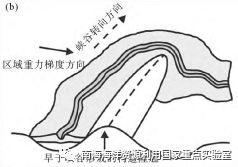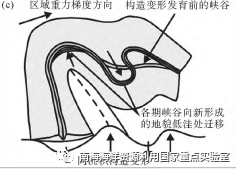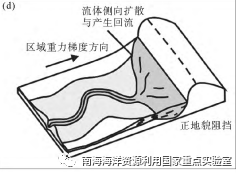海底峡谷
Submarine Canyon
海底峡谷是发育于海底窄而深的长条形负地貌,其成因主要与浊流侵蚀及海底滑坡等因素有关;可以作为陆地和浅海沉积物及有机质向深海搬运的主要通道,在沉积物输移、全球碳循环及深海生物多样性研究等方面有重要意义。海底峡谷常发育于构造变形比较强烈的区域,例如尼日尔河三角洲、下刚果盆地、尼罗河三角洲、墨西哥湾、南海南部文莱深水区与巴巴多斯增生楔等。
Submarine canyons are narrow, deep and long negative landforms developing on the seafloor, and they mainly originate from turbid current erosion and submarine landslides. They can be used as major channels for transporting sediments and organic matters from land and shallow sea to deep sea, and they are important in sediments transport, global carbon cycle and deep-sea biodiversity research. And they often develop in areas with strong tectonic deformation, such as Niger River Delta, Lower Congo Basin, Nile Delta, Gulf of Mexico, Brunei Deep End and Barbados Accretionary Wedge in the southern part of South China Sea.
根据构造变形与海底活动的相互作用,可以将海底峡谷可以划分为5种类型,分别为构造限制型海底峡谷、构造转向型海底峡谷、构造偏转型海底峡谷、构造阻挡型海底峡谷及横向切穿型海底峡谷。
According to the interaction between tectonic deformation and seafloor activities, submarine canyons can be divided into five types and they are tectonically confined submarine canyon, tectonically diverted submarine canyon, tectonically deflected submarine canyon, tectonically blocked submarine canyon and cutting-cross submarine canyon respectively.
①构造限制型海底峡谷:构造限制型海底峡谷被限定在由构造变形产生的相邻2个正地貌单元之间。例如发育于尼日尔河三角洲前缘斜坡上的海底峡谷在流经由两排大型背斜夹持的谷地时,流体下切侵蚀能力增强,峡谷深度增大。
According to the interaction between tectonic deformation and seafloor activities, submarine canyons can be divided into five types and they are tectonically confined submarine canyon, tectonically diverted submarine canyon, tectonically deflected submarine canyon, tectonically blocked submarine canyon and cutting-cross submarine canyon respectively.

②构造转向型海底峡谷:构造转向型海底峡谷是指峡谷行进路径前方被先于峡谷形成的正向构造遮挡,导致峡谷走向发生改变,通常沿着地势最低洼的方向发育,这是狗仔变形区域最为常见的一种海底峡谷类型。Cronin将发育于西班牙东南部Tabernas盆地内的上中新世峡谷于发育于现今海底的Almeria峡谷,发现海底峡谷上游走向与陆坡倾向一致,在流经走向与海底峡谷流向斜交的断层时,峡谷发生转向,改沿斜向断槽发育,其中古峡谷的走向经历了约60°的转向;现今海底峡谷的转向幅度更大,接近90°。
Tectonically diverted submarine canyon. The tectonically diverted submarine canyon refers to the canyon where the canyon’s path is blocked by positive tectonics that form before the canyon, resulting in a change in canyon orientation. This kind of canyon usually grows in the direction of the lowest relief, which is the most common type of submarine canyon in tectonic deformation areas. Cronin compares the Upper Miocene canyon developing in the Tabernas Basin in southeastern Spain with the Almeria canyon developing in the present-day seafloor and finds that the upstream course of the submarine canyon follows the same trend as the terrestrial slope in that the canyons turn when they flow through a fault whose strike diagonally intersects the flow of the submarine canyons, they change to flow along the diagonal channel where the strike of the ancient canyon experiences a turn of about 60° and the present-day submarine canyon has a larger turn of nearly 90°.

③构造偏转型海底峡谷:构造偏转型海底峡谷是指在生长性构造活动的影响下,峡谷的位置持续向新形成的地势低洼部位发生迁移。对Levant盆地的研究发现,持续活动的逆冲推覆构造控制了海底峡谷的走向,导致其持续向新形成的地势低洼处偏转,峡谷一侧发育侧向加积体,另一侧侵蚀过程持续发育;部分峡谷由于偏转幅度剧烈,浊流在偏转位置冲决天然堤,形成新的决口水道。
Tectonically deflected submarine canyon. The tectonically deflected submarine canyon refers to the canyon which continues to shift to newly formed low-lying areas under the influence of growing tectonic activity. The study of Levant Basin finds that the continuously active thrust nappe structure controls the direction of the submarine canyon, resulting in its continuous deflection to newly formed low-lying areas, with lateral accretion developing on one side of the canyon and erosion processes continuing on the other side. Some canyons, due to the dramatic deflection which leads to turbid currents’ breaking through the natural dikes at the deflection position, form new breaching waterways.

④构造阻挡型海底峡谷:构造阻挡型海底峡谷是指大型正地貌构成峡谷前方的阻挡,导致峡谷浊流侧向扩散并产生回流,构造阻挡逆流侧沉积厚度增加,并逐渐向横向延伸。对墨西哥湾深水区海底峡谷的研究中,当峡谷中的浊流遇到盐丘等正地貌阻挡时,浊流物质快速沉积,并形成回流,导致陆坡上局部的负地貌被沉积物快速填平。
Tectonically blocked submarine canyon. The tectonically blocked submarine canyon refers to the canyon where large positive landforms constitute a block in front of the canyon, resulting in lateral diffusion and reflux of turbid currents in the canyon. In the study of submarine canyons in the deep end of Gulf of Mexico, researchers find that when turbid currents in the canyons encounter positive landforms such as salt domes, turbid currents are rapidly deposited and backflow is formed, resulting in the rapid filling of local negative landforms on the land slope by sediments.

⑤横向切穿型海底峡谷:横向切穿型海底峡谷是指海底峡谷顺坡流经平行或斜交陆坡走向的构造变形区域时,峡谷走向未发生明显改变,仍大致沿着原方向持续行进,峡谷切穿下伏构造变形区域。
Cutting-cross submarine canyon. The cutting-cross submarine canyon refers to the submarine canyon flowing down-slope through the tectonic deformation area parallel or oblique to the land slope. Its direction does not change significantly but still continues to travel roughly in the original direction, and it cuts across the underlying tectonic deformation area.

参考文献:
[1]赵家斌,钟广法.构造活动对海底峡谷地貌形态的影响[J].海洋地质前沿,2018,34(12):1-13.
[1]Cronin, B, T. Structurally-controlled deep sea channel courses: examples from the Miocene of southeast Spain and the Alboran Sea, southwest Mediterranean[J]. Geological Society, 1995, 94(1):115-135.
[1]Interactions between submarine channel systems and deformation in deepwater fold belts[J]. Marine and Petroleum Geology, 2009, 26:1466-1482.
 公众号
公众号